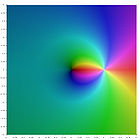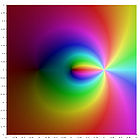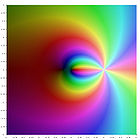Eulerian polynomials
Peter Luschny, 2010−08−18
Definition
The Eulerian polynomials are defined by the exponential generating function
The Eulerian polynomials can be computed by recurrence:
An equivalent way to write this definition is to set the Eulerian polynomials inductively by
The definition given is used by major authors like D. E. Knuth, D. Foata and
F. Hirzebruch. In the older literature (for example in L. Comtet, Advanced
Combinatorics) a slightly different definition is used, namely
Eulerian numbers
The coefficients of the Eulerian polynomials are the Eulerian numbers
[1],
This definition of the Eulerian numbers agrees with the combinatorial
definition in the DLMF[2].
The triangle of Eulerian numbers is also called Euler's triangle
[3].
| An,k |
0 |
1 |
2 |
3 |
4 |
| 0 |
1 |
0 |
0 |
0 |
0 |
| 1 |
1 |
0 |
0 |
0 |
0 |
| 2 |
1 |
1 |
0 |
0 |
0 |
| 3 |
1 |
4 |
1 |
0 |
0 |
| 4 |
1 |
11 |
11 |
1 |
0 |
|
| Cn,k |
0 |
1 |
2 |
3 |
4 |
| 0 |
1 |
0 |
0 |
0 |
0 |
| 1 |
0 |
1 |
0 |
0 |
0 |
| 2 |
0 |
1 |
1 |
0 |
0 |
| 3 |
0 |
1 |
4 |
1 |
0 |
| 4 |
0 |
1 |
11 |
11 |
1 |
|
Euler's definition
is A173018.
The main entry for the Eulerian numbers in the database is
A008292.
It enumerates
with offset (1,1).
The combinatorial interpretation
Let
denote the set of all bijections (one-to-one and onto functions) from
to itself, call an element of
a permutation p and identify it with the ordered list
.
Using the
Iverson bracket [.] the number of ascents of p is defined as
where
. The combinatorial interpretation of
the Eulerian polynomials is then given by
The table below illustrates this representation for the case n = 4.
| p | asc | p | asc | p | asc | p | asc |
| 4321 | 0 |
4231 | 1 |
2413 | 2 |
1423 | 2 |
| 3214 | 1 |
2431 | 1 |
2134 | 2 |
1342 | 2 |
| 3241 | 1 |
4312 | 1 |
2314 | 2 |
4123 | 2 |
| 3421 | 1 |
3142 | 1 |
2341 | 2 |
1324 | 2 |
| 4213 | 1 |
4132 | 1 |
3124 | 2 |
1243 | 2 |
| 2143 | 1 |
1432 | 1 |
3412 | 2 |
1234 | 3 |
The number of permutations of {1, 2, …, n} with n ascents (the central Eulerian numbers)
are listed in A180056.
History

Eulerian polynomials in Institutiones calculi differentialis, 1755
Leonhard Euler introduced the polynomials in 1749
[4] in the form
Euler introduced the Eulerian polynomials in an attempt to evaluate the
Dirichlet eta function
at
. This led him to conjecture the functional
equation of the eta function (which immediately implies the functional equation
of the zeta function). Most simply put, the relation Euler was after was
Though Euler's reasoning was not rigorous by modern standards it was a
milestone on the way to Riemann's proof of the functional equation of the zeta function.
The facsimile shows Eulerian polynomials as given by Euler in his work
Institutiones calculi differentialis, 1755. It is interesting to note that
the original definition of Euler coincides with the definition in the DLMF, 2010.
Eulerian generating functions
We call a generating function an Eulerian generating function iff it has the form
for some polynomial g(t). Many elementary classes of sequences have an Eulerian
generating function. A few examples are collocated in the table below.
For instance the case
-
gives the generating function of the regular orthotopic numbers,
-
gives the generating function of the centered orthotopic numbers.
Plot

|
A1(x) ,
A2(x) ,
A3(x) ,
A4(x)
, A5(x)
, A6(x)
|
Special values of the Eulerian polynomials
Assorted sequences and formulas
Let ∂r denote the denominator of a rational number r.
Eulerian polynomials
and Euler polynomials
have a sequence of values in common (up to a binary shift). Let
denote the Bernoulli polynomials and ζ(n) the Riemann Zeta function.
denotes the Stirling numbers of the second kind. The formulas below show how
rich in content the Eulerian polynomials are.
A155585
for all n ≥ 0 |
|
|
|
|
|
|
|
|
|
|
|
|
The connection with the polylogarithm
Eulerian polynomials are related to the polylogarithm
For nonpositive integer values of s, the polylogarithm is a rational function. The first few are
|
|
|
|
|
|
A plot of these functions in the complex plane is given in the gallery
[5] below.
Polylogarithm functions in the complex plane
|
|
|
|
|
|
|
|
|
In general the explicit formula for nonpositive integer s is
See also
DLMF and the section on series representations of the polylogarithm on
Wikipedia. However, note that the conventions on Wikipedia do not conform to
the DLMF definition of the Eulerian polynomials.
Program
- (Maple) a := proc(n,m) local k;
add((-1)^k*binomial(n+1,k)*(m+1-k)^n,k=0..m) end:
A := proc(n,x) local k; `if`(n=0,1,add(a(n,k)*x^k,k=0..n-1)) end:
Notes
- ↑ The Eulerian number
is not to be confused with the value of the nth Eulerian
polynomial at k. For instance
whereas
is
A122778.
- ↑ Digital Library of
Mathematical Functions, National Institute of Standards and Technology,
Table 26.14.1
- ↑ The name Euler's
triangle is used, for example, in Concrete Mathematics, Table 254. A virtue
of this name is that it might evoke an association to Pascal's triangle, with
which it shares the symmetry between left and right.
- ↑ Euler read his paper
in the Königlichen Akademie der Wissenschaften zu Berlin in the year 1749
("Lu en 1749"). It was published only much later in 1768.
- ↑ Author of the plots of
the polylogarithm functions in the complex plane: Jan Homann. Public domain.
References
- Leonhard Euler,
Remarques sur un beau rapport entre les séries des puissances tant directes
que réciproques, 1768. E352 (Eneström Index), The Euler Archive.
- Dominique Foata and Marcel-Paul Schützenberger,
Théorie Géométrique des Polynômes Eulériens, 1970.
- R. L. Graham, D. E. Knuth and O. Patashnik,
Concrete Mathematics, 1989.
- Friedrich Hirzebruch,
Eulerian polynomials, Münster J. of Math. 1 (2008), 9–14.
- Dominique Foata,
Eulerian
Polynomials: from Euler's Time to the Present. February 18, 2008.
Acknowledgments
This article was originally written for the
OeisWiki. Thanks to Daniel Forgues for editorial help. It is also available in pdf format.







